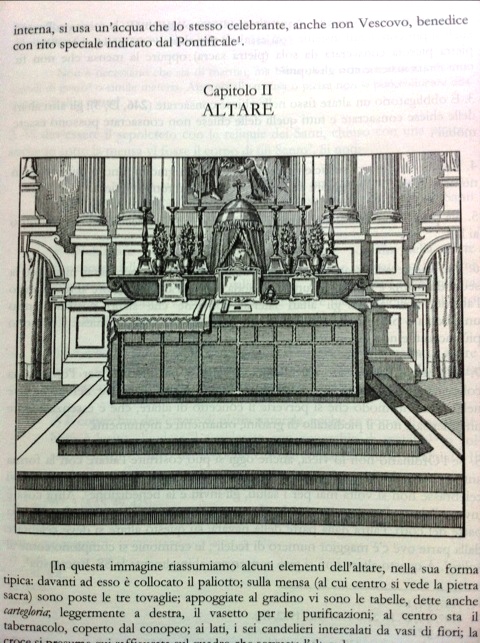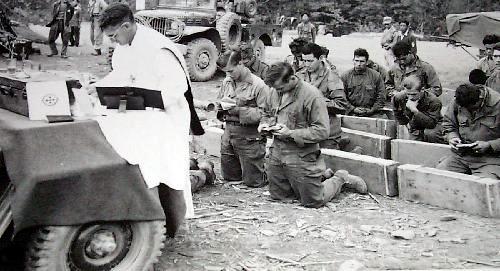From a reader:
A few years ago some modifications were made at our church including raising the floor level of the sanctuary. As a consequence the three steps that used to lead up to the high altar are now just two steps. You can still see the outline of the old bottom step but there is no rise. I have been told that this means it is no longer possible to have a valid TLM. Is this true?
Number of altar steps… valid Mass? O dear O dear O dear.
No, friend. The number of altar steps in now way affects validity of Mass. The number of the priest’s gray cells, on the other hand….
That said, traditionally the number of steps going up to the main altar will be uneven, usually three, five, or seven, including the predella or footpace (the flat platform at the top of the steps). The steps for an altar against the apse or wall should embrace the altar on three sides. Side altars usually have at least one step. Customarily, steps are covered with a carpet.
Here is a shot from my phone of an illustration in Trimeloni.

The reason for the odd number of steps … well… it’s supposed to be symbolic. I suppose 3 for the repetition of Sanctus, Sanctus, Sanctus or for the Trinity, 5 for the wounds of the Lord, and 7 for the virtues. Practically speaking the steps allow the altar to be more visible and for the deacon and subdeacon to arrange themselves in an aesthetically pleasing way.
But, in the final analysis, be there steps or no steps, even or unevenness of number, the validity of Mass is not affected.
UPDATE:



































Nice post Father. For the questioner: even the server guides for the EF allow for there being a different number of steps. Normally the server kneels on the step below the predella; however, if there is no step, then the server kneels on the floor. Whoever said it wouldn’t be valid, well…they probably need to re-examine what constitutes a valid Mass. What about the Masses that were said on the battlefield during the World Wars? I highly doubt they had steps…I’m pretty sure it’s even been said on the back of jeep. Those Masses were valid, were they not?
I think the steps – going up the steps – are symbolic of the approach to Calvary
m
“in the final analysis”… *chuckles*
Maria Montessori writes that the three steps leading to the Altar represent faith, hope, and charity. [Latin Mass for Children]. Such notions are beautiful, and give depth of meaning to the mass beyond what is normally associated with it. So, too, the relics traditionally implanted into the altar. Why give these things up? Do we want a Jansenist, Calvinistic, plain-white, worship space?
Lol, you beat me to it Father. I often like to use the battlefield mass test. It keeps me humble.
Also, the Rood Screen. I think we should re-introduce the Rood (one of the last remaining is at Saint Etienne du Mont in the Latin Quarter of Paris–it’s absolutely beautiful, if you ever get to Paris! The rest were destroyed during the French Revolution).
People may chuckle at this question, but for a few years after MP:SP this is one of the reasons given by the local Archbishop of Anchorage as to why there wouldn’t be a quick rush to celebrate TLM’s around the Archdiocese.
If it isn’t one thing… it is another…
A long quote, but I hope you will excuse it. From Pedro Casciaro’s account of St. Josemaria Escriva celebrating Mass during their escape through the Pyrenees amidst the Spanish Civil War:
Reason no. 4,234,287 for returning to ad orientem. How else can a priest offer Mass on the battlefield, on the back of a jeep?
The Mass in a military field setting, such as the wonderful photo shown at the end of the post, gives some much needed perspective in answer to the reprehensible majority of post-Vatican II clergy who go to any length to prevent the Mass.
A very moving depiction of Mass in the military field setting comes from the Korean War:
http://www.kansas.com/2009/06/20/861375_a861366/father-emil-kapaun.html
Fr. Emil Kapaun (Captain/Chaplain Corps, Servant of God, Distinguished Service Cross, Legion of Merit, Purple Heart) is shown at Mass. using the hood of his jeep as the altar.
Where is that third step so necessary to “validate” that Mass? The obstructionists should be ashamed!
Just curious.
Do the “spirit of V2” types use images such as battlefield masses to excuse masses at private homes?
That said, I recall some one telling me that we can’t have the EF if we are short of deacons. It seems to me that priest missionaries celebrated (EF) masses all over the world w/o deacons and other niceties. Out of necessity.
Our old military bishop, now deceased, was a chaplain during WWII and told us he had once offered Mass standing in a stream, using the bank as the altar. His congregation knelt on the other side of the stream, which was lower.
I had a seminary prof… a sacramental theology guy… once say, “it is very hard to ‘break’ the sacraments.” I know he was not intending to say that “anything goes” — that’s certainly not what he meant. I think there is a comfort to know that no matter how imperfect we are, or how humble the circumstances surrounding the entrance of God into this poor world, that he has given us the clarity to discern his presence by the simple efforts to achieve sacramental matter, form, and intent. We should always try for better, but we should not idolize the perfect.
Presuming no obvious error or corruption in the matter, form, or intent (which need only be a ‘virtual’ intent) directly relating to the sacramental action, there is a great burden of proof, not in figuring out what makes a Mass valid, but in finding somthing that would acutally make a Mass invalid. After having discerned correct matter, form, and intent for the sacramental action (the consecration) there can no longer be the luxury of mere observation or reason to doubt its validity. The Church says that it passes over into a matter of faith. If a matter of faith, any continuing doubts point to a crisis of faith, not in deficiency of circumstance.
What a splendid picture! As a chaplain of Marines I celebrated Holy Mass in such circumstances countless times. Unfortunately the hood of a HMMWV ( Humvee) is too high and sloping, but the tailgate makes a perfect altar. Of course the priest is ad orienten but I never heard a single negative comment from my Marines. In fact, one of them would invariably remark: “Boy, Father, that was great. Just like World War II!” A priest saying Mass on the deck a warship or on the field of battle is the quintessential icon of a military chaplain.
Fr. Aidan Logan, OCso
In the Eclogues Virgil writes “numero deus impare gaudet”: God rejoices in the uneven number.
The ancients at least knew about human instincts like praying in the direction of the rising sun, not touching sacred things with profane hands, etc.
God put those instincts in us at creation to use as tools to worship Him and we should use them.
The image Fr. Z shared of the Mass in the field and the other one, shared by Mike, are quite moving. Thank you for these! I have long thought the millennial generation (folks born 1982-2004) needs to see more of this type of image. This is a (rather?) familiar image to their parents (baby boomers) and their grandparents (g.i. generation folks born 1901-1924). This would be a lovely housewarming gift for a family: a side-by-side framed photograph with a prayer beside it, for a Catholic home.
My favorite military Mass photo shows a battlefield solemn high Mass. apparently on a South Seas island in WWII. Instead of six torch bearers, there are six riflemen. Snapped a the moment of elevation of the Sacred Host after consecration, we see puffs of smoke as the rifles are fired into the sky to salute the Real Presence. Now that’s true reverence!
God bless our intrepid (and improvisational) military chaplains! May they, and their brave congregants in the field, be kept safe from harm as they worship Our Lord!
Henry Edwards-I never heard of a rifle salute to honor the Real Presence after the Consecration! Very cool!
I have to echo Fr Z’s “O dear O dear O dear.” People need to be very careful when undertaking “do it yourself” apologetics (not referring to the asker/reader who posed the question, but the person who told them the number of steps meant no more valid TLMs could be said).